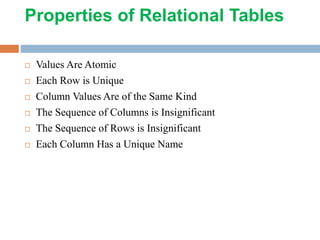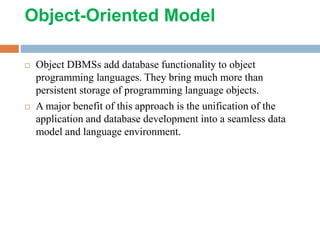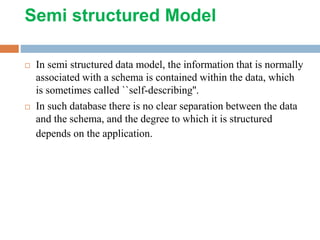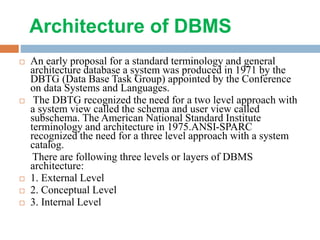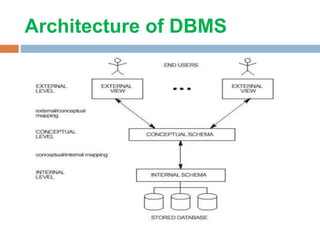Database-management-system-dbms-ppt.pptx
- 1. Submitted To: Submitted By: Miss. Pratibha Pandey Ayush Kumar Seminar On Blockchain Technology
- 2. Content What is Blockchain Technology? Brief History Why Use a DBMS? Purpose of DBMS Data models Architecture of DBMS levels or layers of DBMS architecture Components of DBMS Advantage of DBMS Disadvantage of DBMS DBMS Languages References
- 3. What is Blockchain Technology? The Blockchain is an encrypted, distributed database that records data, or in other words it is a digital ledger of any transactions, contracts - that needs to be independently recorded. Blockchain is an open and distributed ledger that can be used to record transactions between two parties. In Blockchain every transaction is stored on more than one computer, which makes us sure that every transaction is going to be permanent without any fear of loss
- 4. Brief History 2008 Satoshi Nakamoto, a pseudonym for a person or group, publishes “Bitcoin: A Peer-to-Peer Electronic Cash System.“ 2009 The first successful Bitcoin (BTC) transaction occurs between computer scientist Hal Finney and the mysterious Satoshi Nakamoto. 2011 1 BTC = $1USD, giving the cryptocurrency parity with the US dollar. 2013 BTC market cap surpassed $1 billion. Bitcoin reached $100/BTC for first time
- 5. Why to use Blockchain? Blockchain helps in the verification and traceability of multistep transactions needing verification and traceability. Transactions can even be automated with “smart contracts,” which increase your efficiency and speed the process even further. The fact that blockchain is a decentralised way of storing and accessing data makes the whole system incredibly secure.
- 6. Purpose of Blockchain The purpose of blockchain is to allow digital information to be recorded and distributed, but not edited. This technology offers new tools for authentication and authorization in the digital world that fulfil the needs of many centralized administrators. As a result, it enables the creation of new digital relationships. It allows a free cryptocurrency through a decentralized environment.
- 7. Advantages of Blockchain Better Transparency - Transparency is one of the big issues in the current industry. To improve transparency, organizations have tried to implement more rules and regulations. But there is one thing that doesn’t make any system 100% transparency, i.e., centralization. Enhanced Security - Security is also enhanced by the fact that each node holds a copy of the transactions ever performed on the network. So, if any malicious actor ever wanted to make changes in the transaction, he won’t be able to do so as other nodes will reject his request to write transactions to the network. Improved Speed and Highly Efficient- The last industrial benefit that blockchain brings is improved efficiency and speed. Blockchain solves the time-consuming process and automates them to maximize efficiency. It also eradicates human-based errors with the help of automation.
- 8. Network Model The popularity of the network data model coincided with the popularity of the hierarchical data model. Some data were more naturally modeled with more than one parent per child. So, the network model permitted the modeling of many-to- many relationships in data. In 1971, the Conference on Data Systems Languages (CODASYL) formally defined the network model.
- 9. Relational Model (RDBMS - relational database management system) A database based on the relational model developed by E.F. Code. A relational database allows the definition of data structures, storage and retrieval operations and integrity constraints. In such a database the data and relations between them are organized in tables. A table is a collection of records and each record in a table contains the same fields.
- 10. Properties of Relational Tables Values Are Atomic Each Row is Unique Column Values Are of the Same Kind The Sequence of Columns is Insignificant The Sequence of Rows is Insignificant Each Column Has a Unique Name
- 11. Object-Oriented Model Object DBMSs add database functionality to object programming languages. They bring much more than persistent storage of programming language objects. A major benefit of this approach is the unification of the application and database development into a seamless data model and language environment.
- 12. Semi structured Model In semi structured data model, the information that is normally associated with a schema is contained within the data, which is sometimes called ``self-describing''. In such database there is no clear separation between the data and the schema, and the degree to which it is structured depends on the application.
- 13. Architecture of DBMS An early proposal for a standard terminology and general architecture database a system was produced in 1971 by the DBTG (Data Base Task Group) appointed by the Conference on data Systems and Languages. The DBTG recognized the need for a two level approach with a system view called the schema and user view called subschema. The American National Standard Institute terminology and architecture in 1975.ANSI-SPARC recognized the need for a three level approach with a system catalog. There are following three levels or layers of DBMS architecture: 1. External Level 2. Conceptual Level 3. Internal Level
- 15. levels or layers of DBMS architecture External Level: - External Level is described by a schema i.e. it consists of definition of logical records and relationship in the external view. Conceptual Level: - Conceptual Level represents the entire database. Conceptual schema describes the records and relationship included in the Conceptual view. . Internal Level: - Internal level indicates hoe the data will be stored and described the data structures and access method to be used by the database.
- 16. Components of DBMS 1. Hardware: Can range from a PC to a network of computers. 2. Software: DBMS, operating system, network software (if necessary) and also the application programs. 3. Data: Used by the organization and a description of this data called the schema. 4. People: Includes database designers, DBAs, application programmers, and end-users. 5. Procedure: Instructions and rules that should be applied to the design and use of the database and DBMS.
- 17. Advantage of DBMS Controlling Redundancy Sharing of Data Data Consistency Integration of Data Integration Constraints Data Security Report Writers
- 18. Advantage of DBMS… Control Over Concurrency Backup and Recovery Procedures Data Independence
- 19. Disadvantage of DBMS Cost of Hardware and Software Cost of Data Conversion Cost of Staff Training Appointing Technical Staff Database Damage
- 20. DBMS Languages Data Definition Language-DDL Data Definition Language (DDL) statements are used to define the database structure or schema. Some examples: CREATE - to create objects in the database ALTER - alters the structure of the database DROP - delete objects from the database TRUNCATE - remove all records from a table, including all spaces allocated for the records are removed COMMENT - add comments to the data dictionary RENAME - rename an object
- 21. Data Manipulation Language (DML) Data Manipulation Language (DML) statements are used for managing data within schema objects. Some examples: SELECT - Retrieve data from the a database INSERT - Insert data into a table UPDATE - Updates existing data within a table DELETE - deletes all records from a table, the space for the records remain MERGE - UPSERT operation (insert or update) CALL - Call a PL/SQL or Java subprogram EXPLAIN PLAN - explain access path to data LOCK TABLE - control concurrency









